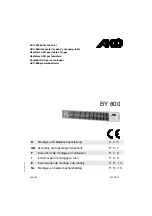
0108RPVDGBEN
20
SECTION 12 USER INSTRUCTIONS RPV 2000 AIR HEATERS
SPECIAL NOTE
The following instructions have been written
assuming that the RPV 2000 air heater is installed
as a heating module independent of being
installed within an air handling appliance. When
installed within an air handling appliance or as
part of a multi-appliance/purpose system it is
necessary to read any supplementary instructions
supplied with the apparatus in conjunction with
this document.
OPERATING
How the gas fired air heater works:
Gas is burned by an atmospheric burner which
fires into a heat exchanger. The gas burner is
controlled by a double gas valve via an electronic
burner control, which is actuated automatically
via external controls i.e. a room thermostat and/or
a time switch. The burner is ignited by a hot
surface igniter. When the burner fires and warms
the heat exchanger, the heat is sensed by a
thermally actuated fan control which switches on
the fan when the air temperature has reached its
preset operating level.
At the end of a heating cycle the burner is
switched off, the air circulation fan will continue
to run until the air heater has cooled to a safe
condition. Thereafter the fan will remain off until
the next cycle is initiated.
NOTE:
Alternative burner ignition systems may be
specified dependant upon the specific
requirements for heating. The mode of automatic
operation remains as herein described. Flame
sensing may be via a separate detector.
Safety:
1. Flame failure is detected by the hot surface
igniter which is also the sensor (see note
above) and will immediately result in gas
valve shut down.
2. Safety against overheating is assured by two
overheat controls. The first is an automatic
recycle control which protects against low
air flow i.e. clogged air ways, fan failure etc.
The second, which is set to a higher level
than the first one, is a control which locks
out and switches off the burner in the event
of gross overheating for any reason. Manual
intervention is necessary to reset this control
device. Resetting of the automatic burner
control may also be required.
3. The location of the air heater should be
maintained at normal atmospheric pressure.
Changes to the building after air heater
installation, should have regard to the
heating installation, i.e. structural changes
causing excessive draughts from doors,
windows etc. Other air handlers and
installation of air extraction equipment which
may cause a negative pressure environment,
can seriously affect the operation of this
type of air heater, especially if combustion
air supply is not ducted.
To light the heater:
1. Turn on the gas supply to the air heater.
2. Switch on the electricity supply to the air
heater.
3. Ensure time switch (if fitted) is set to a 'ON'
cycle.
4. Adjust control/room thermostat to desired
temperature.
5. Air heater will light automatically when the
room thermostat calls for heat.
6. If the appliance does not light:
a)
check that the burner control does not
require resetting. An indicator light glows at
the front panel of the appliance and on a
remote control if fitted). Reset by pushing
light/button on appliance or the remote
control.
b)
check if thermal overheat control requires
resetting (see fig. 11 key ??).
7. If the thermal overheat control requires
resetting and doing so restarts the air heater,
wait until the appliance warms to thermal
equilibrium, to ensure the overheat control
does not lock out again.
If it does and the
temperature near the heater is less than
30
°°°°
C, then switch off the appliance and call
for service.
If the temperature is over 30
°
C,
take appropriate action to reduce the
ambient temperature near the air heater.
Air circulation:
1. The space heating process is for air to be
circulated through the appliance whereby it
gains heat from a heat exchanger. The air is
directly discharged into the space to be
heated. The air is eventually re-circulated,
therefore, it is very important that an
unobstructed path for the circulation of the
air will be maintained. This is particularly
important if the air heater has been installed
to blow through the wall between two
rooms.



































